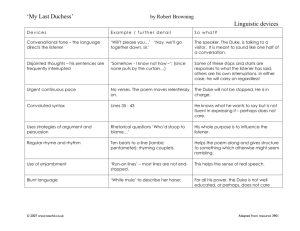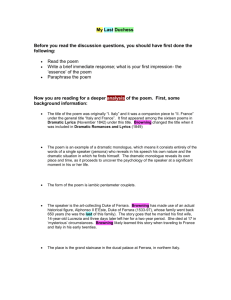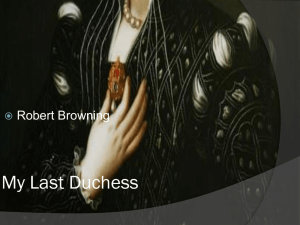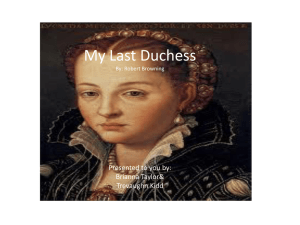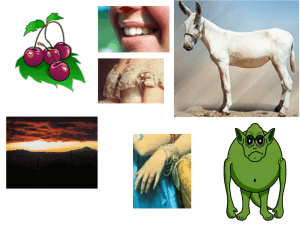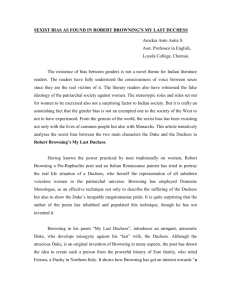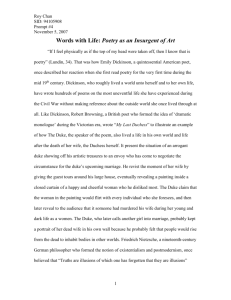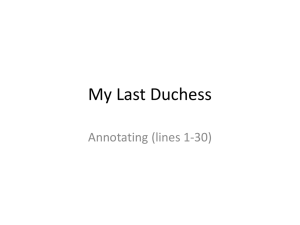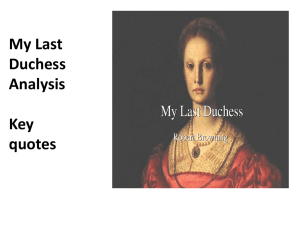`My Last Duchess` and
advertisement
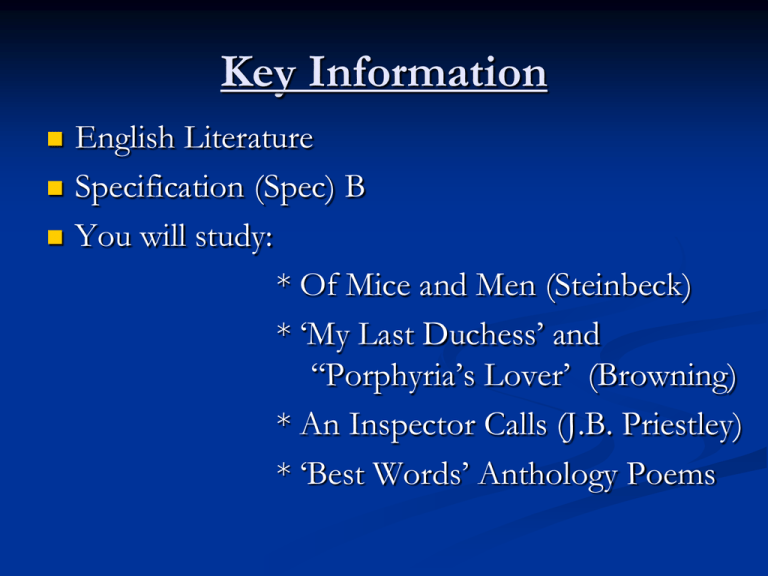
Key Information English Literature Specification (Spec) B You will study: * Of Mice and Men (Steinbeck) * ‘My Last Duchess’ and ‘‘Porphyria’s Lover’ (Browning) * An Inspector Calls (J.B. Priestley) * ‘Best Words’ Anthology Poems ‘My Last Duchess’ and ‘Porphyria’s Lover’ Robert Browning is the poet. The main theme in these poems is love. There are numerous poetic devices used by Browning. We will be exploring these poems in depth over the next few lessons. You will then complete an essay for your coursework folder that will count towards your final mark/grade. Think about: Different types of relationships Unrequited love Romeo and Juliet, Antony and Cleopatra, Mary and Joseph Rom Coms Marriage Celebrity couples (Jordan and Peter/Alex) Love for a sport/material thing/food! True love Young love In pairs… Create a mind map of words, images and symbols that explain what love is. After this… Create your own definition of love using no more than 10 words. The dictionary says: 1. 2. 3. 4. 5. 6. To have great attachment to and affection for To have passionate desire, longing, and feelings for. To like or desire (to do something) very much. To make love to. To be in love. An intense emotion of affection, warmth, fondness, and regard towards a person or thing. Homework Find at least five facts about the life and times of Robert Browning You will be sharing these next lesson Assessment Objectives: AO1: Respond to texts critically, sensitively and in detail, selecting appropriate ways to convey your response, using textual evidence (quotes) as appropriate AO2: Explore how language, structure and forms contribute to the meanings of texts, considering different approaches to texts and alternative interpretations AO3: Explore relationships and comparisons between texts, selecting and evaluating relevant material (NOT wiki-pedia)!!! AO4: Relate texts to their social, cultural and historical contexts and literary traditions Starter Activity: Write two of your facts on a post it note and stick on the board We will review this as a class and see how much information we have discovered LO: To explore the context of MLD and predict the ideas that shape the poem *MLD = My Last Duchess ‘My Last Duchess’ The language is not easy to understand on first glance You need to absorb yourself in the world of the Duke… All will become clear very soon The poet himself… The poem is a dramatic monologue. Details: Browning first published poem under the title "I. Italy" in 1842 in Dramatic Lyrics, a collection of sixteen Browning poems. Browning changed the title of the poem to "My Last Duchess" before republishing it in 1849 in another collection, Dramatic Romances and Lyrics. Remember this fact. When you read the poem later think about the significance of the change in title. What difference would this make? Ferrara, Italy Italy is/was a place of… Every dramatic monologue has a speaker. The speaker in ‘My Last Duchess’ is a Duke. Let’s meet this man… The Duke * What does this man’s facial expression tell us? *What do his clothes reveal? *Does he look happy? *What does his stance do? * Why is he stood this way? Duchess * What does this woman’s facial expression tell us? *What do her clothes reveal? *Does she look happy? * Is this a natural portrait?! Fra Pandolf Artist What would be behind these curtains? ‘Her mantle laps over her lady’s wrist too much’ Arrogance My Last Duchess ‘The dropping of the daylight in the West’ The Duchess likes the simple things in life… ‘the bough of cherries’ ‘My gift of a nine hundred years old name’ Aristocrat • Would you enjoy a party with this man? • What does his stature/ body language show? • Could you imagine being married to this man? Neptune Roman name for Poseidon, god of the sea in Greek mythology. Who does this remind you of? Starter Activity: Write the alphabet in your book like this… A N B O C P D Q E R F S G T H U I V J W K X L Y M Z Try to think of a word that links to MLD for each letter! LO: To analyse the form/structure, language, imagery, rhythm and themes of MLD How can I do all that? With a little bit of a ‘flirt’! F orm/structure L anguage I magery R hythm T hemes In groups of 4 Work through the task card Make notes in your books Think about what the answer ‘might’ be Put down a few ideas if you all think differently Task Cards Pronouns/Names •Create a tally chart of all the pronouns in MLD •Who else features in the MLD? List them and explain who they are. •What does this tell you? Imagery •Identify all of the images created •Draw them to create a simple storyboard for the MLD (It does not have to be arty/amazing)! Death/Violence Body/Actions •Identify all of the words that link to death/violence •Identify all of the words linked with body parts or actions •What do they reveal about the Duke? •What themes emerge? •Which phrase shows the Duke had the Duchess killed? Vocabulary/Words: You may need a dictionary! •Identify all of the words that are difficult/you don’t know the meaning of •Find the meaning •Why are they used by Browning? •What do these words reveal? Rhythm •Look at the last words of every line – what do you notice? •Read each line aloud in turns – how many beats are in each line? •Why is the monologue structured in this way? Share your discoveries! SITUATION: An Italian Duke is talking to a messenger from a wealthy Count. The messenger has come to bring an offer of marriage between the Count’s daughter and the Duke. The Duke spends most of the Dramatic Monologue bragging about his wealth and aristocratic lineage. More disturbingly, he calmly relates how his previous wife (“my last Duchess”) was disposed of because, basically, she had offended his vanity. LANGUAGE/POETIC TECHNIQUES The poem is a fine example of how a Dramatic Monologue can reveal attitude and character – not only through what is said but through the way it has been spoken because it allows us to focus solely on the speaker. His last Duchess is never referred to by name, signifying the way she was a mere possession for him. Also, the word “last” could just mean “previous” but it could imply “last” in a long line of previous wives! This is ironic given that the conversation is about arranging for a new wife! He is clearly materialistic as he is more attached to his painting of his wife than to her memory and he uses the painting as an excuse to brag about his power, “since none puts by/The curtain I have drawn for you, but I” – with the emphasis on his favourite word – “I”. He also brags about the name of a famous painter who was employed by him. He does the same later in the poem, bragging about his rare bronze statue cast by “Claus of Innsbruck”. His name-dropping is a feature of his aristocratic snobbery. He refers to his wife as the painting with the words, “That’s…” and “There she stands…” (repeated twice in the poem) – both signifying his emotional coldness and distance from her. It is quite clear that the Duke is about to re-marry for money – the dowry paid by the father of the bride. The duke vows that he is primarily interested in the Count’s “fair daughter” – but this is only after mentioning the need to receive a generous dowry from the Count! He asserts that it is the daughter who is his “object” – a revealing word because he collects objects and he treated his previous wife as a material possession – in fact he has turned her into a possession hung on the wall which only he can view! His desire to control people is perhaps symbolised by his choice of bronze: “Neptune, though,/Taming a sea-horse”. He is callous and we know his wife has died (“As if alive”) and we suspect that he has had her killed. He reveals his cold and calculating nature in the almost monosyllabic utterance: “This grew; I gave commands;/Then all smiles stopped together”. The simplicity and lack of emotion in these words is what is frightening because he is (most probably) describing murdering his wife. His motive for murder is also quite disturbing. There is a hint of sexual jealousy – but no more than that: “She thanked men, - good!” The exclamation mark signifies his sarcasm and his bitterness – a rare sign of emotion from beneath his mask. However, his main reason for killing his wife stems from his own arrogance that anything else in the world should give her pleasure apart from him. His extreme egotism pervades the poem. He is angry that she speaks to ordinary people in a civilised way and does not treat them as inferior beings to him! He comments that “she let/Herself be lessoned so”, referring to her ability to take criticism and learn from it. But he is punning on the word “lessoned” (“lessened”), here, because he believes that accepting criticism belittles (lessens) a person. Similarly, the assonance in, “I choose/Never to stoop” emphasises the Duke’s sense of superiority over the rest of the world. So, her common politeness – “stooping” to curtsey – was her real crime, in his eyes. He arrogantly describes his previous marriage as “my gift (to his wife) of a nine hundred-yearsold name” emphasising that his aristocratic title and heritage makes him superior. The constant repetition of “I”, “me”, “my”, “mine” throughout the poem emphasises his egocentric nature. STRUCTURE: Ostensibly, the Duke is polite, sophisticated and controlled in his speech and this makes it even more chilling when we discover the darkness below the surface. Both the language and the structure work together to help us gain an insight into his persona. The elevated language is the Duke showing off his educated side: “that pictured countenance” (face) and, “your master’s known munificence” (generosity). These are two examples of his over-wordy speech. Structurally, the fact that there are no stanza breaks and that the Count speaks uninterrupted for 56 lines points to a man who likes the sound of his own voice and is full of his own importance. The use of heroic (rhyming) couplets gives the poem a controlled structure which suits the dominating personality of the Duke. There is plenty of enjambement to allow the speech some fluency to mimic natural speech. The poem is full of controlled asides and deliberated digressions in mid-sentence which effectively captures the pattern of natural speech but which also gives us a picture of the Duke as a calm and reasoning person. This logical reasoning does not include any positive emotions – like, love for another. The repeated use of pauses created by the dashes, the use of brackets (parenthesis), the rhetorical questions and the Duke’s quoting and imagining of others’ words gives us a picture of a highly logical and calculating mind e.g. “A heart – how shall I say – too soon made glad” and “but thanked - /Somehow – I know not how – as if she ranked”. Similarly very long and multi-clausal sentences and deliberately unusual word order (e.g.“I know not how”) show off the Duke’s education and his arrogance. So, lines 5-13, 13-21 and 48-53 are each single sentences. Unusual word order, “So, not the first/Are you to turn and ask thus”. This all makes the Duke sound like a pompous and conceited snob – which he is! His comment that he has no skill in speaking is clearly false modesty on his part: “Even had you skill/In speech – ( which I have not) – ”. This controlled section of his speech itself, ironically, demonstrates clearly that he does have such skill! The sophistication of the Duke’s syntax and the elevated diction (vocabulary) reflect the Duke’s feelings of superiority. This calm and reasoned style contrasts with the psychopathic tendencies lurking beneath the surface and the irrationality of killing his wife on the basis of her having “a heart too soon made glad” by anything (e.g. the white mule) – rather than solely by himself. The use of cheerful rhyming couplets contrasts ironically with the subject matter of murder and the politeness and gentility of the Duke’s language is very ironic, given his dark actions: “sir” (repeated four times in the poem), “Will’t please you sit…” and “Will’t please you rise?” add to the ironically polite tone.
